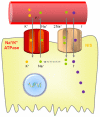Sodium iodide symporter for nuclear molecular imaging and gene therapy: from bedside to bench and back
- PMID: 22539935
- PMCID: PMC3337731
- DOI: 10.7150/thno.3722
Sodium iodide symporter for nuclear molecular imaging and gene therapy: from bedside to bench and back
Abstract
Molecular imaging, defined as the visual representation, characterization and quantification of biological processes at the cellular and subcellular levels within intact living organisms, can be obtained by various imaging technologies, including nuclear imaging methods. Imaging of normal thyroid tissue and differentiated thyroid cancer, and treatment of thyroid cancer with radioiodine rely on the expression of the sodium iodide symporter (NIS) in these cells. NIS is an intrinsic membrane protein with 13 transmembrane domains and it takes up iodide into the cytosol from the extracellular fluid. By transferring NIS function to various cells via gene transfer, the cells can be visualized with gamma or positron emitting radioisotopes such as Tc-99m, I-123, I-131, I-124 and F-18 tetrafluoroborate, which are accumulated by NIS. They can also be treated with beta- or alpha-emitting radionuclides, such as I-131, Re-186, Re-188 and At-211, which are also accumulated by NIS. This article demonstrates the diagnostic and therapeutic applications of NIS as a radionuclide-based reporter gene for trafficking cells and a therapeutic gene for treating cancers.
Keywords: gene therapy; molecular imaging; radionuclide-based imaging; radionuclide.; sodium iodide symporter.
Conflict of interest statement
Competing Interests: The authors have declared that no competing interest exists.
Figures






Similar articles
-
[18F]Tetrafluoroborate ([18F]TFB) and its analogs for PET imaging of the sodium/iodide symporter.Theranostics. 2018 Jun 24;8(14):3918-3931. doi: 10.7150/thno.24997. eCollection 2018. Theranostics. 2018. PMID: 30083270 Free PMC article. Review.
-
Functional Radionuclide Imaging, In-Vitro Radioiodine Uptake Estimation and RT-PCR in the Evaluation of Sodium Iodide Symporter (NIS) Expression and Functionality in Breast Cancer: A Pilot Study.Indian J Surg Oncol. 2013 Mar;4(1):80-91. doi: 10.1007/s13193-012-0205-8. Epub 2013 Jan 5. Indian J Surg Oncol. 2013. PMID: 24426705 Free PMC article.
-
Sodium iodide symporter: its role in nuclear medicine.J Nucl Med. 2002 Sep;43(9):1188-200. J Nucl Med. 2002. PMID: 12215558 Review.
-
The sodium iodide symporter (NIS): novel applications for radionuclide imaging and treatment.Endocr Relat Cancer. 2021 Sep 3;28(10):T193-T213. doi: 10.1530/ERC-21-0177. Endocr Relat Cancer. 2021. PMID: 34259647 Review.
-
Establishment of radioactive astatine and iodine uptake in cancer cell lines expressing the human sodium/iodide symporter.Eur J Nucl Med Mol Imaging. 2002 Jul;29(7):842-54. doi: 10.1007/s00259-002-0784-7. Epub 2002 Apr 11. Eur J Nucl Med Mol Imaging. 2002. PMID: 12111124
Cited by
-
In Vivo Myoblasts Tracking Using the Sodium Iodide Symporter Gene Expression in Dogs.Mol Ther Methods Clin Dev. 2020 Jan 9;17:317-327. doi: 10.1016/j.omtm.2019.12.011. eCollection 2020 Jun 12. Mol Ther Methods Clin Dev. 2020. PMID: 32577429 Free PMC article.
-
Optimization of multimodal imaging of mesenchymal stem cells using the human sodium iodide symporter for PET and Cerenkov luminescence imaging.PLoS One. 2014 Apr 18;9(4):e94833. doi: 10.1371/journal.pone.0094833. eCollection 2014. PLoS One. 2014. PMID: 24747914 Free PMC article.
-
Positive radionuclide imaging of miRNA expression using RILES and the human sodium iodide symporter as reporter gene is feasible and supports a protective role of miRNA-23a in response to muscular atrophy.PLoS One. 2017 May 11;12(5):e0177492. doi: 10.1371/journal.pone.0177492. eCollection 2017. PLoS One. 2017. PMID: 28493972 Free PMC article.
-
Tumor microenvironment affects exogenous sodium/iodide symporter expression.Transl Oncol. 2021 Jan;14(1):100937. doi: 10.1016/j.tranon.2020.100937. Epub 2020 Nov 17. Transl Oncol. 2021. PMID: 33217645 Free PMC article.
-
Reduction of Salivary Gland Damage During Radioiodine Therapy for Differentiated Thyroid Cancers.Nucl Med Mol Imaging. 2020 Jun;54(3):126-127. doi: 10.1007/s13139-020-00643-w. Epub 2020 May 12. Nucl Med Mol Imaging. 2020. PMID: 32582395 Free PMC article. No abstract available.
References
-
- Riesco-Eizaguirre G, Santisteban P. A perspective view of sodium iodide symporter research and its clinical implications. Eur J Endocrinol. 2006;155:495–512. - PubMed
-
- Soto GD, Halperin I, Squarcia M, Lomena F, Domingo MP. Update in thyroid imaging. The expanding world of thyroid imaging and its translation to clinical practice. Hormones (Athens) 2010;9:287–98. - PubMed
-
- Verburg FA, de Keizer B, van Isselt JW. Use of radiopharmaceuticals for diagnosis, treatment, and follow-up of differentiated thyroid carcinoma. Anticancer Agents Med Chem. 2007;7:399–409. - PubMed
-
- Dai G, Levy O, Carrasco N. Cloning and characterization of the thyroid iodide transporter. Nature. 1996;379:458–60. - PubMed
LinkOut - more resources
Full Text Sources
Other Literature Sources

